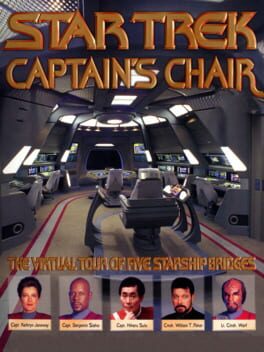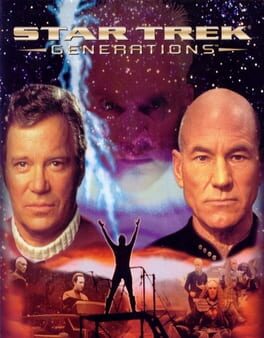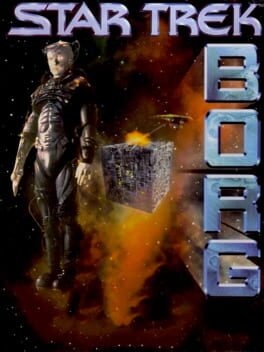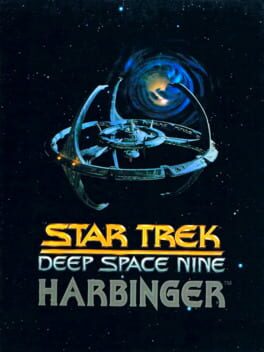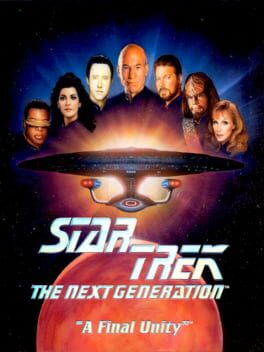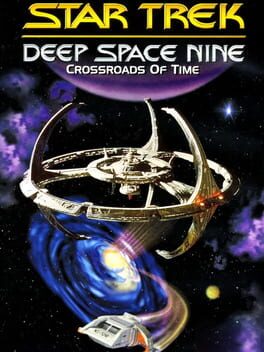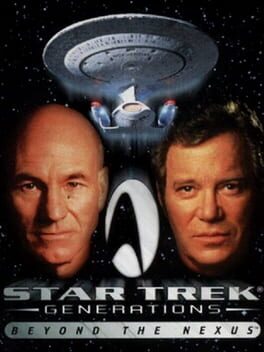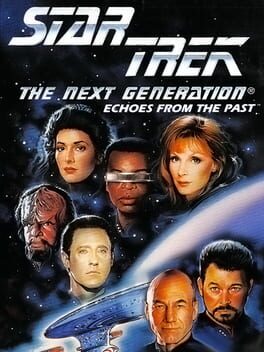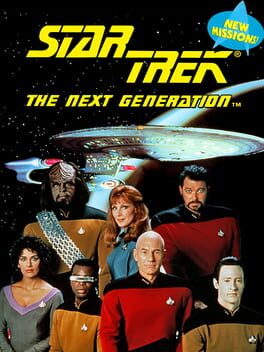Cube1701
Another interactive CD-ROM, this time focusing on the bridges of the original Enterprise, Enterprise D, Defiant, Voyager and Enterprise E (plus a hidden Klingon Bird of Prey bridge). Each bridge has a lot of locations to view from (in 360 degrees) and you can zoom into every single panel on the bridge. Some of them have buttons you can press, and even a couple of simple games.
Sulu, Worf, Sisko, Janeway and Riker all give tours of the bridges, talking about each station. Janeway’s tour is the most fascinating, as it’s written from the perspective of before the ship launched, so the only other character mentioned is Harry Kim (none of the other people officially assigned to Voyager are part of the main cast). It’s also referred to “The Voyager” a lot, which sounds odd.
Sulu, Worf, Sisko, Janeway and Riker all give tours of the bridges, talking about each station. Janeway’s tour is the most fascinating, as it’s written from the perspective of before the ship launched, so the only other character mentioned is Harry Kim (none of the other people officially assigned to Voyager are part of the main cast). It’s also referred to “The Voyager” a lot, which sounds odd.
This game is definitely intriguing. It very loosely follows the story of Star Trek Generations, with Soren trying to destroy stars in order to change the path of the mysterious energy ribbon called the Nexus. In this game, Soren needs to destroy multiple starts to get what he wants, and you need to stop him – you can even prevent him from destroying the Amargosa star.
Most of the game is played in a first person view. The controls definitely feel very dated, but are one of the things that makes the game interesting. The directional buttons move forward/backwards and turns while the mouse aims the cursor. On the bottom of the screen, you control your inventory, scanning and map. The big square in the middle will show you objects you can interact with when you get close to them, which is a really nice touch. On the top of the screen, your phaser will aim at that part of the screen. It’s very different to the first person controls we’re used to now.
In these levels you’ll shoot through enemies and solve puzzles. Sometimes, you’ll even beam down in disguise and can do a lot before you have to resort to shooting. The graphics are extremely charming and are surprisingly nice to look at. When you get hurt a lot, you’ll be beamed up and the mission will have failed – however, you can fail a few missions before you lose the game.
Between missions, you’ll use Stellar Cartography to scan planets and stars in order to work out where you next have to go. You’ll also sometimes encounter enemy ships and use a pretty poor interface to fight them with. All the good parts are in the missions.
The missions are quite interesting. One has you infiltrate a Romulan base as Troi, one involves Crusher investigating a living planet and fighting giant antibodies (it reminds me a bit of the Voyager episode “Macrocosm” and the Chodak from Future’s Past/Final Unity even pop up.
Eventually, you’ll reach Veridian III. As Geordi is never captured in this game, things play out differently. Picard ends up in the Nexus (which is just a flashing blank screen as he asks Kirk for help), then Kirk delays Soren and falls off a bridge. Soren then beams to the Enterprise and initiates a warp core overload. After separating the saucer, Picard beams to the stardrive section and stops Soren from destroying the saucer (although he does enough damage that it has to crash land) before finding an escape pod with a sleeping Spot and watching the stardrive section blow up in a very impressive cutscene that looks like it’s actually using the studio models.
Although that’s not the only ending – you can actually fully defeat Soren. He brings a large fleet with him to Veridian III, but if you manage to disable his ship, he’ll self-destruct. The Enterprise D warps off unscathed and Kirk will still be in the Nexus.
Most of the game is played in a first person view. The controls definitely feel very dated, but are one of the things that makes the game interesting. The directional buttons move forward/backwards and turns while the mouse aims the cursor. On the bottom of the screen, you control your inventory, scanning and map. The big square in the middle will show you objects you can interact with when you get close to them, which is a really nice touch. On the top of the screen, your phaser will aim at that part of the screen. It’s very different to the first person controls we’re used to now.
In these levels you’ll shoot through enemies and solve puzzles. Sometimes, you’ll even beam down in disguise and can do a lot before you have to resort to shooting. The graphics are extremely charming and are surprisingly nice to look at. When you get hurt a lot, you’ll be beamed up and the mission will have failed – however, you can fail a few missions before you lose the game.
Between missions, you’ll use Stellar Cartography to scan planets and stars in order to work out where you next have to go. You’ll also sometimes encounter enemy ships and use a pretty poor interface to fight them with. All the good parts are in the missions.
The missions are quite interesting. One has you infiltrate a Romulan base as Troi, one involves Crusher investigating a living planet and fighting giant antibodies (it reminds me a bit of the Voyager episode “Macrocosm” and the Chodak from Future’s Past/Final Unity even pop up.
Eventually, you’ll reach Veridian III. As Geordi is never captured in this game, things play out differently. Picard ends up in the Nexus (which is just a flashing blank screen as he asks Kirk for help), then Kirk delays Soren and falls off a bridge. Soren then beams to the Enterprise and initiates a warp core overload. After separating the saucer, Picard beams to the stardrive section and stops Soren from destroying the saucer (although he does enough damage that it has to crash land) before finding an escape pod with a sleeping Spot and watching the stardrive section blow up in a very impressive cutscene that looks like it’s actually using the studio models.
Although that’s not the only ending – you can actually fully defeat Soren. He brings a large fleet with him to Veridian III, but if you manage to disable his ship, he’ll self-destruct. The Enterprise D warps off unscathed and Kirk will still be in the Nexus.
A game that will be sharing a name with a Star Trek show. Starfleet Academy is sort of a reimagining of Starfleet Academy Bridge Simulator on SNES/32X, as it features the same style of gameplay and some of the same cadets, but with a new story, new characters and a completely different set of missions.
The first things that strikes you is the live action cutscenes. These often look odd as none of the actors were filmed on set, they were instead filmed separately and imposed onto the backgrounds. The cutouts can be very rough at times, but its somehow still very charming, especially as everyone is taking it seriously, including William Shatner, Walter Koenig, and George Takei in their last official live action appearances. You also get to make choices which impacts your ratings – if you don’t make the right ones, you won’t get to play a bonus mission at the end of the game.
The game uses a mixture of a joystick (or controller) and keyboard and it works quite well, even if it takes a bit of getting used to. It offers a lot more control than the SNES/32X games, but at the same time it also feels like you’re doing everything yourself instead of commanding a crew. The combat is still only forward phasers/torpedoes, but it feels a lot more fluid than any of the previous space combat, and it helped out by a full screen view that displays all needed information.
While this further separates you from the crew, it’s very much required for playing the game. The missions are almost entirely combat related, with a few where you can avoid encounters. None of the missions particularly stood out to me, other than one where you casually pass through the Galactic Barrier with a really nice cutscene.
Starfleet Academy is an interesting game, especially with the cutscenes. The gameplay can be frustrating at times (especially as you can very quickly have systems knocked out, a big pain if it’s impulse or weapons), but for the most part it’s fun to play.
The first things that strikes you is the live action cutscenes. These often look odd as none of the actors were filmed on set, they were instead filmed separately and imposed onto the backgrounds. The cutouts can be very rough at times, but its somehow still very charming, especially as everyone is taking it seriously, including William Shatner, Walter Koenig, and George Takei in their last official live action appearances. You also get to make choices which impacts your ratings – if you don’t make the right ones, you won’t get to play a bonus mission at the end of the game.
The game uses a mixture of a joystick (or controller) and keyboard and it works quite well, even if it takes a bit of getting used to. It offers a lot more control than the SNES/32X games, but at the same time it also feels like you’re doing everything yourself instead of commanding a crew. The combat is still only forward phasers/torpedoes, but it feels a lot more fluid than any of the previous space combat, and it helped out by a full screen view that displays all needed information.
While this further separates you from the crew, it’s very much required for playing the game. The missions are almost entirely combat related, with a few where you can avoid encounters. None of the missions particularly stood out to me, other than one where you casually pass through the Galactic Barrier with a really nice cutscene.
Starfleet Academy is an interesting game, especially with the cutscenes. The gameplay can be frustrating at times (especially as you can very quickly have systems knocked out, a big pain if it’s impulse or weapons), but for the most part it’s fun to play.
1996
The second interactive movie game. This follows Cadet Furlong who is being sent to a starbase ahead of a Borg invasion 10 years after the Battle of Wolf 359. Wishing he was fighting the Borg instead, as he lost his father at the Battle of Wolf 359, the cadet ends up being visited by Q. Q offers him a chance at saving his father and sends the cadet to the past, taking the place of the security officer and Q taking place of the medic.
The whole game is made up of live action footage, and John de Lancie gets plenty of screen time and is wonderful through the whole thing. The cast of new characters are also really good, too. At points in the “film” you get to make choices or solve puzzles, with Q resetting you if you mess up. I found that I much preferred picking the “wrong” options so I could see all the footage – you can never get tired of Q teasing you.
Because of Q resetting things, I think this works better than the Klingon game. I also really like that they make use of the bad choices as you sometimes need information from them to progress though the correct path.
There's a fan-made remaster called "Star Trek: Brog - Remastered" which upscales all the video and it looks amazing - check out that version.
The whole game is made up of live action footage, and John de Lancie gets plenty of screen time and is wonderful through the whole thing. The cast of new characters are also really good, too. At points in the “film” you get to make choices or solve puzzles, with Q resetting you if you mess up. I found that I much preferred picking the “wrong” options so I could see all the footage – you can never get tired of Q teasing you.
Because of Q resetting things, I think this works better than the Klingon game. I also really like that they make use of the bad choices as you sometimes need information from them to progress though the correct path.
There's a fan-made remaster called "Star Trek: Brog - Remastered" which upscales all the video and it looks amazing - check out that version.
1996
This is an interactive movie game, where you watch clips before being presented with a choice. Where you click on (or choosing not to click) will either end the game or let you proceed.
This is presented as a holonovel made by Gowron (Robert O’Reilly), where he wants to teach weaklings about how to be a true Klingon so you can be a worthy opponent. In the holonovel, you take the place as a Klingon boy on his Rite of Ascension when his father stops an assassination attempt on Gowron. You then embark on a journey to find out who is behind everything.
The game aspect of this is quite poor, as all but the right option lead to someone shouting at you and the game resetting to just before – the Borg game is much more creative in terms of using the interactive movie mechanic. The story, however, is interesting with some fun moments. It’s a good insight into Klingon culture. On YouTube, there are two ways of watching this: if you want to enjoy the story, you can watch the “correct path” version, which turns it into a fun Klingon episode of Star Trek. You can also watch a version with all the failure clips, with lots of wonderful overacting.
This is presented as a holonovel made by Gowron (Robert O’Reilly), where he wants to teach weaklings about how to be a true Klingon so you can be a worthy opponent. In the holonovel, you take the place as a Klingon boy on his Rite of Ascension when his father stops an assassination attempt on Gowron. You then embark on a journey to find out who is behind everything.
The game aspect of this is quite poor, as all but the right option lead to someone shouting at you and the game resetting to just before – the Borg game is much more creative in terms of using the interactive movie mechanic. The story, however, is interesting with some fun moments. It’s a good insight into Klingon culture. On YouTube, there are two ways of watching this: if you want to enjoy the story, you can watch the “correct path” version, which turns it into a fun Klingon episode of Star Trek. You can also watch a version with all the failure clips, with lots of wonderful overacting.
DS9 Harbinger is a Myst-style adventure game. Each part of the level is made up of still images, with you clicking the edge of the screen to move around and turn in very limited places. This allows the game to look very impressive visually, especially in screenshots. The 3D models of the characters look impressive for the time and everyone is wonderfully voice acted, using the original cast of DS9.
You play a diplomat named Bannick, called to DS9 to assist an ambassador in speaking with a new alien race called the Scythians. These aliens speak in an unusual manner and nobody other than the ambassador has been able to figure it out. As you reach DS9, you get attacked by drones (in an impressive FMV cutscene) and crash land. The drones stat building up to attack DS9. To make matters worse, when you visit the ambassador you discover that he has been murdered. You need to solve the murder, work out how to talk to the Scythians and find a way to stop the drones.
The part of the game on DS9 is great (once you get your head around navigating the station), with lots of conversation options and an intriguing mystery. Puzzles are mostly self-enclosed, leaving you to focus more on the narrative mystery.
In a few parts of the game, you have to man the weapons of DS9 (and a runabout). These sections are just click to shoot, but are surprisingly difficult and not fun at all.
The latter half of the game, once you leave DS9, is much more of a challenging puzzle game like Myst, where you have to navigate a maze (not easy due to how you move, working out how to ger around DS9 was difficult enough), and is very much a chore, especially as you have large periods with no talking. That said, working out how to trick the AIs in charge and talking to them towards the ends is a lot of fun.
Unfortunately, they couldn’t get the full cast of DS9 for this game, so O’Brien and Bashir are said to be on a mission (Worf hasn’t joined the cast yet). You do get to spend plenty of time with Sisko, Odo, Dax, Quark and Kira, though, so there’s still a lot of interaction with the crew.
You play a diplomat named Bannick, called to DS9 to assist an ambassador in speaking with a new alien race called the Scythians. These aliens speak in an unusual manner and nobody other than the ambassador has been able to figure it out. As you reach DS9, you get attacked by drones (in an impressive FMV cutscene) and crash land. The drones stat building up to attack DS9. To make matters worse, when you visit the ambassador you discover that he has been murdered. You need to solve the murder, work out how to talk to the Scythians and find a way to stop the drones.
The part of the game on DS9 is great (once you get your head around navigating the station), with lots of conversation options and an intriguing mystery. Puzzles are mostly self-enclosed, leaving you to focus more on the narrative mystery.
In a few parts of the game, you have to man the weapons of DS9 (and a runabout). These sections are just click to shoot, but are surprisingly difficult and not fun at all.
The latter half of the game, once you leave DS9, is much more of a challenging puzzle game like Myst, where you have to navigate a maze (not easy due to how you move, working out how to ger around DS9 was difficult enough), and is very much a chore, especially as you have large periods with no talking. That said, working out how to trick the AIs in charge and talking to them towards the ends is a lot of fun.
Unfortunately, they couldn’t get the full cast of DS9 for this game, so O’Brien and Bashir are said to be on a mission (Worf hasn’t joined the cast yet). You do get to spend plenty of time with Sisko, Odo, Dax, Quark and Kira, though, so there’s still a lot of interaction with the crew.
This feels like a Next Generation movie. It’s a point and click adventure that starts off with a few loose plot points and missions that all start coming together as the Federations, Romulans and a newly discovered race called the Chodak (who also appear in Future’s Past with a similar plot) race to find a device that can alter reality anywhere in the galaxy. It’s all voiced by the cast of The Next Generation, with all the main crew getting pivotal moments in the story (although Troi’s main input is astrology, her empath and counselling isn’t really used in the game).
The game has multiple levels of depth and control. On the Enterprise, you can choose to manually alter repair teams and power output or let La Forge handle it for you. In ship combat, you can control the Enterprise manually or delegate it to Worf. Although the combat is very broken on modern systems, so letting Worf handle it is the only option (the system looks quite in depth). Ships exploding also tends to crash he game, so be sure to save, but luckily the Enterprise D mainly faces stripped down Romulan warbirds and Worf handles them with ease – although one odd thing about this game is that every enemy self destructs once defeated.
On away missions, you can also manually select an away team or let the game choose for you. While the first is nice for hearing different dialogue, you often need a specific character to perform a task and going back to the Enterprise and returning is a big faff, so it’s best to stick to the game’s recommendation. I think it rotates the cast quite nicely so they all have a part to play.
For the point and click puzzles, they start off great with lots of interactions that make sense, unfortunately the game devolves to extremely obscure solutions and objects you interact with can blend in with the background. It even has multiple moments where you can fail the game, but the game doesn’t tell you and lets you carry on. Although sometimes there are multiple solutions. There’s one part where you get to solve a puzzle if you pick up a random bit of metal (a paper clip), other wise you’ll have to shoot some sensors.
Even with those issues, A Final Unity is a great game and is well worth it for the story. It’s a shame that this hasn’t gotten a re-release that makes it easier to play (installing the game is a faff) and fixes up a few of the issues.
The game has multiple levels of depth and control. On the Enterprise, you can choose to manually alter repair teams and power output or let La Forge handle it for you. In ship combat, you can control the Enterprise manually or delegate it to Worf. Although the combat is very broken on modern systems, so letting Worf handle it is the only option (the system looks quite in depth). Ships exploding also tends to crash he game, so be sure to save, but luckily the Enterprise D mainly faces stripped down Romulan warbirds and Worf handles them with ease – although one odd thing about this game is that every enemy self destructs once defeated.
On away missions, you can also manually select an away team or let the game choose for you. While the first is nice for hearing different dialogue, you often need a specific character to perform a task and going back to the Enterprise and returning is a big faff, so it’s best to stick to the game’s recommendation. I think it rotates the cast quite nicely so they all have a part to play.
For the point and click puzzles, they start off great with lots of interactions that make sense, unfortunately the game devolves to extremely obscure solutions and objects you interact with can blend in with the background. It even has multiple moments where you can fail the game, but the game doesn’t tell you and lets you carry on. Although sometimes there are multiple solutions. There’s one part where you get to solve a puzzle if you pick up a random bit of metal (a paper clip), other wise you’ll have to shoot some sensors.
Even with those issues, A Final Unity is a great game and is well worth it for the story. It’s a shame that this hasn’t gotten a re-release that makes it easier to play (installing the game is a faff) and fixes up a few of the issues.
This Deep Space Nine game for the Super Nintendo and Mega Drive is a 2D platformer. There’s lots of running, jumping as well as shooting Bajorans, Cardassians and….bats, the ultimate “we can’t think of anything else” enemy type used in many licensed games of this era.
Like many of those games, this one isn’t very good. It has nice graphics and some really great music (although it really doesn’t fit the game), the levels are just confusing mazes with some backtracking to get keys, rooms and doors that look similar and some even have time limits. The story itself is decent, with a group of Bajoran extremists trying to destroy DS9, and they even create a story reason to jump into Sisko’s traumatic past (that said, it is a bit of a weak reason).
At the start of each chapter, you need to investigate around DS9, you get to explore the promenade and ops and talk to the characters. These parts of the game are great. It’s a shame that the game wasn’t more of a mystery and puzzle with a bit of platforming and shooting in between, instead of the opposite way around.
In previous reviews, I’ve treated different versions as different games, but the differences here are much smaller. The biggest difference is the music. While the rocking tunes of the Mega Drive version don’t fit, the music is just as jarring in the SNES version but also sound awful. You can also shoot diagonally downwards, so there’s a small extra bit at the start of the Bajoran level where you shoot some rats.
Like many of those games, this one isn’t very good. It has nice graphics and some really great music (although it really doesn’t fit the game), the levels are just confusing mazes with some backtracking to get keys, rooms and doors that look similar and some even have time limits. The story itself is decent, with a group of Bajoran extremists trying to destroy DS9, and they even create a story reason to jump into Sisko’s traumatic past (that said, it is a bit of a weak reason).
At the start of each chapter, you need to investigate around DS9, you get to explore the promenade and ops and talk to the characters. These parts of the game are great. It’s a shame that the game wasn’t more of a mystery and puzzle with a bit of platforming and shooting in between, instead of the opposite way around.
In previous reviews, I’ve treated different versions as different games, but the differences here are much smaller. The biggest difference is the music. While the rocking tunes of the Mega Drive version don’t fit, the music is just as jarring in the SNES version but also sound awful. You can also shoot diagonally downwards, so there’s a small extra bit at the start of the Bajoran level where you shoot some rats.
The missions of this are similar to the SNES game. It was made for the Sega 32X add-on for the Mega Drive. The biggest difference for this is the graphics, which look much cleaner and less pixelated and the 3D models have a lot more texture and detail to them.
Playing this game on a standard 3-button Mega Drive controller is a nightmare as you need to press combinations for basic features, but the 6-button is good – although using the face buttons to tilt instead of shoulder buttons isn’t as intuitive (that said, you rarely need to do it). The one thing I couldn’t work out to do is how to pause the game.
Another addition to this version is pool, which you can play against your fellow cadets (or a second player). There’s not really a lot to it, it’s just a standard top down pool game.
The control nitpicks aside, this is a really nice version of the game. The wider screen gives a bigger view. The bridge itself looks more like an actual starship bridge rather than the more video game look of the SNES one.
Playing this game on a standard 3-button Mega Drive controller is a nightmare as you need to press combinations for basic features, but the 6-button is good – although using the face buttons to tilt instead of shoulder buttons isn’t as intuitive (that said, you rarely need to do it). The one thing I couldn’t work out to do is how to pause the game.
Another addition to this version is pool, which you can play against your fellow cadets (or a second player). There’s not really a lot to it, it’s just a standard top down pool game.
The control nitpicks aside, this is a really nice version of the game. The wider screen gives a bigger view. The bridge itself looks more like an actual starship bridge rather than the more video game look of the SNES one.
I was quite impressed by this game. It’s a series of 20 simulations (plus some bonus ones) where you command a team of Starfleet Academy students. The main buttons are used for flying (thankfully you can turn off inverted controls) and weapons, with the L and R buttons being used to spin the ship, which is more control than previous games. Press the select button and the viewscreen will bring up a menu where you can give commands to your crew – sensors, red alert, hailing and things like that.
The missions start off with little focus on combat, one has you moving a radioactive asteroid from the planet, the most interesting one has you investigate a protostar which ends up with contact with a new species, others have you investigate missing/destroyed ships. A few of them let you complete your objective and leave an area without defeating the enemies there.
Each mission concludes with the lesson it was built to teach, and will also give you a score based on your performance, telling you anything you did wrong (I kept forgetting to cancel red alert when going back to starbase). If you fail and get a score of zero, you’re supposed to carry on finishing the current set of 5 missions and redoing all of them if you don’t reach 75% (or just use the passwords to reload the mission – which makes it strange that it isn’t just an option).
After you complete the 20 missions you get your final mission: deliver some supplies. When you start, you get hailed by a ship called the Kobayashi Maru, which is losing power but has stranded into the neutral zone. I was surprised that you aren’t forced into combat and I was able to choose the option of getting higher ups to ask the Klingons to help, as I don’t think the mission is worth starting a war over. You can also enter codes in the character creation (it’s just male/female and some pre-set names) to unlock names. If you play as James T. Kirk, you get to play an alternate version of the test.
While the later mission are mores combat focused, which still feels a bit clunky as you can only fire directly forwards, I found it to be a mostly enjoyable game. It also has some very early 3D, and they’ve done well with the limited resources of the SNES.
The missions start off with little focus on combat, one has you moving a radioactive asteroid from the planet, the most interesting one has you investigate a protostar which ends up with contact with a new species, others have you investigate missing/destroyed ships. A few of them let you complete your objective and leave an area without defeating the enemies there.
Each mission concludes with the lesson it was built to teach, and will also give you a score based on your performance, telling you anything you did wrong (I kept forgetting to cancel red alert when going back to starbase). If you fail and get a score of zero, you’re supposed to carry on finishing the current set of 5 missions and redoing all of them if you don’t reach 75% (or just use the passwords to reload the mission – which makes it strange that it isn’t just an option).
After you complete the 20 missions you get your final mission: deliver some supplies. When you start, you get hailed by a ship called the Kobayashi Maru, which is losing power but has stranded into the neutral zone. I was surprised that you aren’t forced into combat and I was able to choose the option of getting higher ups to ask the Klingons to help, as I don’t think the mission is worth starting a war over. You can also enter codes in the character creation (it’s just male/female and some pre-set names) to unlock names. If you play as James T. Kirk, you get to play an alternate version of the test.
While the later mission are mores combat focused, which still feels a bit clunky as you can only fire directly forwards, I found it to be a mostly enjoyable game. It also has some very early 3D, and they’ve done well with the limited resources of the SNES.
A game loosely based on Star Trek Generations. It uses the Advanced Holodeck Tutorial as a basis and adds more modes (although more minigames) to kind of tell the story. It starts off on the Enterprise B on it’s maiden voyage when it suddenly gets attacked by Tholians.
The ship combat is a very simplified version of the previous game. There’s no commands to give anyone, just turn and shoot. It’s also much easier as you rarely get hit, but combat still drags on. After this, you need to track a distress call by playing a minigame similar to Mastermind where you enter symbols and the game tells you how many are the correct symbol and how many are in the right place. The third minigame has you flying through squares, with another involving you laying down pipes. After doing a few of these a few times, the game cuts forward to the Enterprise D, skipping Kirk’s apparent death.
The Enterprise D section follows the same minigames, and adds some basic top-down on foot-sections where you shoot enemies as you run to Soren. You do a few at Amargosa Station, track the Klingon Bird of Prey, do a few more, blow up the Bird of Prey and get a message saying that the Enterprise had to crash on the planet but everyone is saved. Considering the game is called “Beyond the Nexus”, there’s nothing actually involving the Nexus.
However, you do get a screen saying that there’s a hidden final level, but can only access if you can name the ship that rescued the crew at the end of the film. This last mission is just another code breaking minigame followed by a final still of Picard and the description of “The Body of James T Kirk is laid to rest”, even though he’s not been mentioned since he fixed something on the Enterprise B.
Beyond the Nexus is a very easy minigame collection that poorly tells the story of Star Trek Generations. The most disappointing thing is that the Generations theme music isn’t even in the game.
There’s also a Game Boy version which is the exact same game but with fewer colours (it supports colour for the Super Game Boy, but still not as advanced as the Game Gear version).
The ship combat is a very simplified version of the previous game. There’s no commands to give anyone, just turn and shoot. It’s also much easier as you rarely get hit, but combat still drags on. After this, you need to track a distress call by playing a minigame similar to Mastermind where you enter symbols and the game tells you how many are the correct symbol and how many are in the right place. The third minigame has you flying through squares, with another involving you laying down pipes. After doing a few of these a few times, the game cuts forward to the Enterprise D, skipping Kirk’s apparent death.
The Enterprise D section follows the same minigames, and adds some basic top-down on foot-sections where you shoot enemies as you run to Soren. You do a few at Amargosa Station, track the Klingon Bird of Prey, do a few more, blow up the Bird of Prey and get a message saying that the Enterprise had to crash on the planet but everyone is saved. Considering the game is called “Beyond the Nexus”, there’s nothing actually involving the Nexus.
However, you do get a screen saying that there’s a hidden final level, but can only access if you can name the ship that rescued the crew at the end of the film. This last mission is just another code breaking minigame followed by a final still of Picard and the description of “The Body of James T Kirk is laid to rest”, even though he’s not been mentioned since he fixed something on the Enterprise B.
Beyond the Nexus is a very easy minigame collection that poorly tells the story of Star Trek Generations. The most disappointing thing is that the Generations theme music isn’t even in the game.
There’s also a Game Boy version which is the exact same game but with fewer colours (it supports colour for the Super Game Boy, but still not as advanced as the Game Gear version).
This game is heavily based on Future’s Past, but considering they both came out only a few months apart, there are a surprising amount of differences.
The game starts off with a lovely pixelated recreation of the opening of The Next Generation, which makes it feel even more like an episode of the show. There’s also a lot more dialogue in this game as the characters you meet have conversations with Picard instead of just a single paragraph at the end. Missions are mostly the game, but with slightly different layouts that make things look slightly more like actual locations, although they’re still difficult mazes. Using items is more fiddly due to the lack of shoulder buttons.
The combat is mostly the same, but ships seem to move a lot faster. This causes the sensor grid to zoom in an out a lot, which I found to be extremely nauseating. If you can put up with that, I do recommend this version due to the improved dialogue – with the exception of one change where the mission is something given to Picard and not the crew (the objective recaps now take place in the ready room instead of the briefing room).
The game starts off with a lovely pixelated recreation of the opening of The Next Generation, which makes it feel even more like an episode of the show. There’s also a lot more dialogue in this game as the characters you meet have conversations with Picard instead of just a single paragraph at the end. Missions are mostly the game, but with slightly different layouts that make things look slightly more like actual locations, although they’re still difficult mazes. Using items is more fiddly due to the lack of shoulder buttons.
The combat is mostly the same, but ships seem to move a lot faster. This causes the sensor grid to zoom in an out a lot, which I found to be extremely nauseating. If you can put up with that, I do recommend this version due to the improved dialogue – with the exception of one change where the mission is something given to Picard and not the crew (the objective recaps now take place in the ready room instead of the briefing room).
This one took a bit of getting used to due to some fiddly buttons and confusing menus. The Enterprise is monitoring Romulan Activity in the Neutral Zone and ends up in an epic quest to be chosen to be given an extremely powerful weapon – one that the Romulans and a new race called the Chodak.
The game starts off with a view of the Enterprise D bridge. Here you look around at the various stations. Some (like the Computer and Sensors) give you additional information, the Briefing Room has Picard explain the current objective to the crew (a really nice touch) and the main one – the conn lets you set a course. There are a lot of places to choose from, although there’s not much reason to visit most, not to mention that the game bugs you if you’re not doing the current objective.
While at warp, you may randomly encounter enemy ships. The focus on ship combat is a top-down view and is very basic and quite annoying. You’re also supposed to keep an eye out for a little notification that the enemy ship is surrendering (although there’s no penalty for blowing them up). When you get damaged, your ship’s systems will go down and you’ll have to assign resources to each one. You can go to a starbase to completely repair (which also creates a password to save the game), but I found that as most of the game it was navigation or engines that were down, you just had to leave the game for a few minutes and let the admiral yell at you for not doing the current objective.
When you go on an away mission, you get to pick your away team (in most cases). You’ll want to take Data on every possible mission as he has the best stats and can see in the dark, which is the only ability that makes a difference (and only on one mission). Some crew completely lack phasers (like Dr. Crusher). I found myself using Data, La Forge, Worf and a random ensign on most missions.
These missions involve a lot of shooting, some puzzle solving and a lot of aimlessly walking around the maze-like levels. There’s some interesting ideas here, as you can swap between the away team and take them separate routes or command them to follow one person.
I feel like a sequel for this could have had the potential to fix the issues with this game. There’s some good ideas, but ultimately isn’t executed very well.
The game starts off with a view of the Enterprise D bridge. Here you look around at the various stations. Some (like the Computer and Sensors) give you additional information, the Briefing Room has Picard explain the current objective to the crew (a really nice touch) and the main one – the conn lets you set a course. There are a lot of places to choose from, although there’s not much reason to visit most, not to mention that the game bugs you if you’re not doing the current objective.
While at warp, you may randomly encounter enemy ships. The focus on ship combat is a top-down view and is very basic and quite annoying. You’re also supposed to keep an eye out for a little notification that the enemy ship is surrendering (although there’s no penalty for blowing them up). When you get damaged, your ship’s systems will go down and you’ll have to assign resources to each one. You can go to a starbase to completely repair (which also creates a password to save the game), but I found that as most of the game it was navigation or engines that were down, you just had to leave the game for a few minutes and let the admiral yell at you for not doing the current objective.
When you go on an away mission, you get to pick your away team (in most cases). You’ll want to take Data on every possible mission as he has the best stats and can see in the dark, which is the only ability that makes a difference (and only on one mission). Some crew completely lack phasers (like Dr. Crusher). I found myself using Data, La Forge, Worf and a random ensign on most missions.
These missions involve a lot of shooting, some puzzle solving and a lot of aimlessly walking around the maze-like levels. There’s some interesting ideas here, as you can swap between the away team and take them separate routes or command them to follow one person.
I feel like a sequel for this could have had the potential to fix the issues with this game. There’s some good ideas, but ultimately isn’t executed very well.
When I first saw the name, I though it was a strange way of downplaying a game to make it sound not so good. But after playing the NES and Game Boy versions of this game (which didn’t have the subtitle), it’s actually a pretty fair description for the game.
The Game Gear version of this features a little splash screen explaining that it’s training missions on a holodeck at Starfleet Academy (that information was only in the manuals for the other versions), as well as some nice shots of the Enterprise D going to warp, with better use of colour throughout the game.
While the game still isn’t good, the Game Gear version is definitely the best version of it.
The Game Gear version of this features a little splash screen explaining that it’s training missions on a holodeck at Starfleet Academy (that information was only in the manuals for the other versions), as well as some nice shots of the Enterprise D going to warp, with better use of colour throughout the game.
While the game still isn’t good, the Game Gear version is definitely the best version of it.
By far the most impressive thing about this game is how they’ve managed to fit so much stuff on just a D-pad, A, B, Select and Start. The controls aren’t good by any stretch, it’s just impressive that they could do so much with so few buttons.
In this, you command the crew of the Enterprise D. Well, four of them at least. Worf will turn on/off shields and weapons. Data will set courses for systems and orbit planets. La Forge will boost power to some systems and sort out repairs. O’ Brian is the most involved with controlling the transporter. Riker tells you the time. You use the D-pad to select who you want to give a command to and A to confirm.
Pressing the select button will put you in a mode where you fly the ship and shoot phasers/torpedoes. However, to change speed you have to go back to the command mode and press forward/back.
The game itself is random missions that generally involve flying somewhere, shooting stuff and then transporting. It’s a fairly dull combat simulator and not much more. When you beam stuff up (cargo or hostages), you get a nice little minigame, but that’s all there is.
In this, you command the crew of the Enterprise D. Well, four of them at least. Worf will turn on/off shields and weapons. Data will set courses for systems and orbit planets. La Forge will boost power to some systems and sort out repairs. O’ Brian is the most involved with controlling the transporter. Riker tells you the time. You use the D-pad to select who you want to give a command to and A to confirm.
Pressing the select button will put you in a mode where you fly the ship and shoot phasers/torpedoes. However, to change speed you have to go back to the command mode and press forward/back.
The game itself is random missions that generally involve flying somewhere, shooting stuff and then transporting. It’s a fairly dull combat simulator and not much more. When you beam stuff up (cargo or hostages), you get a nice little minigame, but that’s all there is.
